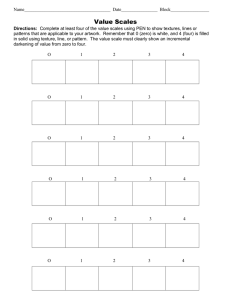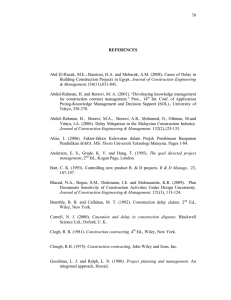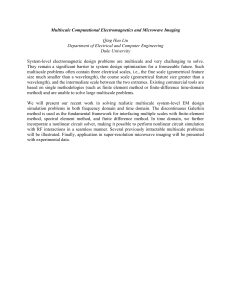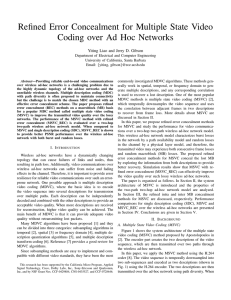Towards Intelligent Mission Profiles of Micro Air Vehicles: Multiscale
advertisement
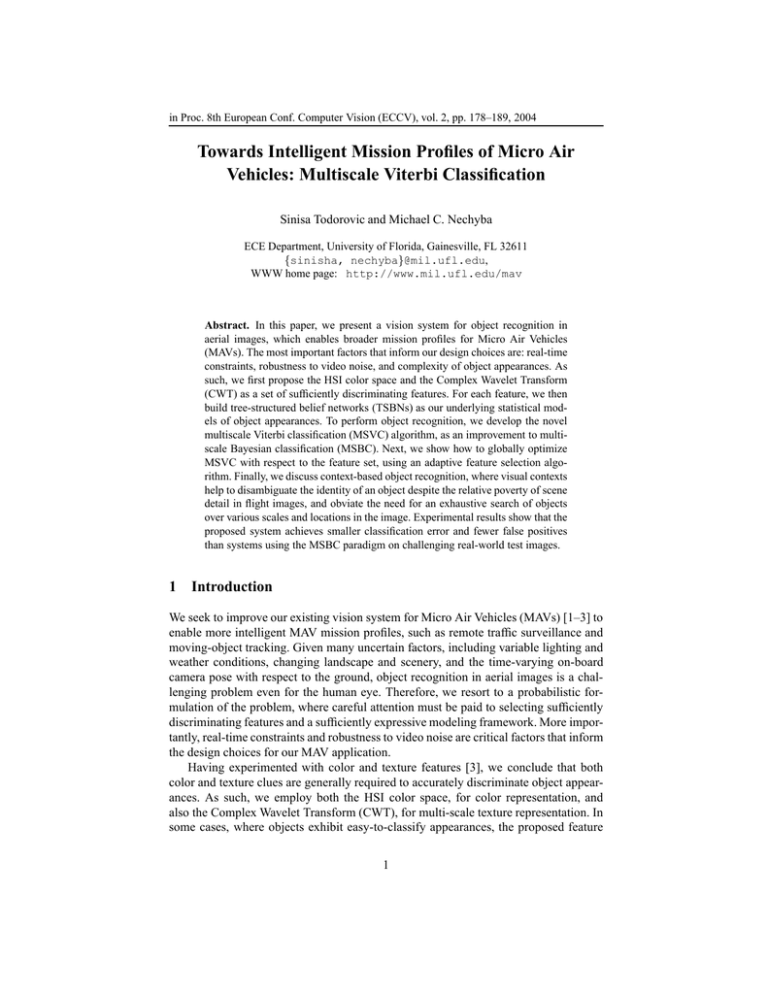
in Proc. 8th European Conf. Computer Vision (ECCV), vol. 2, pp. 178–189, 2004
Towards Intelligent Mission Profiles of Micro Air
Vehicles: Multiscale Viterbi Classification
Sinisa Todorovic and Michael C. Nechyba
ECE Department, University of Florida, Gainesville, FL 32611
{sinisha, nechyba}@mil.ufl.edu,
WWW home page: http://www.mil.ufl.edu/mav
Abstract. In this paper, we present a vision system for object recognition in
aerial images, which enables broader mission profiles for Micro Air Vehicles
(MAVs). The most important factors that inform our design choices are: real-time
constraints, robustness to video noise, and complexity of object appearances. As
such, we first propose the HSI color space and the Complex Wavelet Transform
(CWT) as a set of sufficiently discriminating features. For each feature, we then
build tree-structured belief networks (TSBNs) as our underlying statistical models of object appearances. To perform object recognition, we develop the novel
multiscale Viterbi classification (MSVC) algorithm, as an improvement to multiscale Bayesian classification (MSBC). Next, we show how to globally optimize
MSVC with respect to the feature set, using an adaptive feature selection algorithm. Finally, we discuss context-based object recognition, where visual contexts
help to disambiguate the identity of an object despite the relative poverty of scene
detail in flight images, and obviate the need for an exhaustive search of objects
over various scales and locations in the image. Experimental results show that the
proposed system achieves smaller classification error and fewer false positives
than systems using the MSBC paradigm on challenging real-world test images.
1 Introduction
We seek to improve our existing vision system for Micro Air Vehicles (MAVs) [1–3] to
enable more intelligent MAV mission profiles, such as remote traffic surveillance and
moving-object tracking. Given many uncertain factors, including variable lighting and
weather conditions, changing landscape and scenery, and the time-varying on-board
camera pose with respect to the ground, object recognition in aerial images is a challenging problem even for the human eye. Therefore, we resort to a probabilistic formulation of the problem, where careful attention must be paid to selecting sufficiently
discriminating features and a sufficiently expressive modeling framework. More importantly, real-time constraints and robustness to video noise are critical factors that inform
the design choices for our MAV application.
Having experimented with color and texture features [3], we conclude that both
color and texture clues are generally required to accurately discriminate object appearances. As such, we employ both the HSI color space, for color representation, and
also the Complex Wavelet Transform (CWT), for multi-scale texture representation. In
some cases, where objects exhibit easy-to-classify appearances, the proposed feature
1
in Proc. 8th European Conf. Computer Vision (ECCV), vol. 2, pp. 178–189, 2004
set is not justifiable in light of real-time processing constraints. Therefore, herein, we
propose an algorithm for selecting an optimal feature subspace from the given HSI and
CWT feature space that considers both correctness of classification and computational
cost.
Given this feature set, we then choose tree-structured belief networks (TSBNs) [4],
as underlying statistical models to describe pixel neighborhoods in an image at varying scales. We build TSBNs for both color and wavelet features, using Pearl’s message
passing scheme [5] and the EM algorithm [6]. Having trained TSBNs, we then proceed
with supervised object recognition. In our approach, we exploit the idea of visual contexts [7], where initial identification of the overall type of scene facilitates recognition of
specific objects/structures within the scene. Objects (e.g., cars, buildings), the locations
where objects are detected (e.g., road, meadow), and the category of locations (e.g., sky,
ground) form a taxonomic hierarchy. Thus, object recognition in our approach consists
of the following steps. First, sky/ground regions in the image are identified. Second,
pixels in the ground region1 are labeled using the learned TSBNs for predefined locations (e.g., road, forest). Finally, pixels of the detected locations of interest are labeled
using the learned TSBNs for a set of predefined objects (e.g., car, house).
To reduce classification error (e.g., “blocky segmentation”), which arises from the
fixed-tree structure of TSBNs, we develop the novel multiscale Viterbi classification
(MSVC) algorithm, an improved version of multiscale Bayesian classification (MSBC)
[8, 9]. In the MSBC approach, image labeling is formulated as Bayesian classification
at each scale of the tree model, separately; next, transition probabilities between nodes
at different scales are learned using the greedy classification-tree algorithm, averaging
values over all nodes and over all scales; finally, it is assumed that labels at a “coarse
enough” scale of the tree model are statistically independent. On the other hand, in our
MSVC formulation, we perform Bayesian classification only at the finest scale, fusing
downward the contributions of all the nodes at all scales in the tree; next, transition
probabilities between nodes at different scales are learned as histogram distributions
that are not averaged over all scales; finally, we assume dependent class labels at the
coarsest layer of the tree model, whose distribution we again estimate as a histogram
distribution.
2 Feature Space
Our feature selection is largely guided by extensive experimentation reported in our
prior work [3], where we sought a feature space, which spans both color and texture
domains, and whose extraction meets our tight real-time constraints.
We obtained the best classification results when color was represented in the HSI
color space. Tests suggested that hue (H), intensity (I) and saturation (S) features were
more discriminative, when compared to the inherently highly correlated features of the
RGB and other color systems [10]. Also, first-order HSI statistics proved to be sufficient
and better than the first and higher-order statistics of other color systems.
For texture-feature extraction, we considered several filtering, model-based and
statistical methods. Our conclusion agrees with the comparative study of Randen et
1
Recognition of objects in the sky region can be easily incorporated into the algorithm.
2
in Proc. 8th European Conf. Computer Vision (ECCV), vol. 2, pp. 178–189, 2004
al. [11], which suggests that for problems where many textures with subtle spectral differences occur, as in our case, it is reasonable to assume that spectral decomposition by
a filter bank yields consistently superior results over other texture analysis methods. Our
experimental results also suggest that it is necessary to analyze both local and regional
properties of texture. Most importantly, we concluded that a prospective texture analysis tool must have high directional selectivity. As such, we employ the complex wavelet
transform (CWT), due to its inherent representation of texture at different scales, orientations and locations [12]. The CWT’s directional selectivity is encoded in six bandpass
subimages of complex coefficients at each level, coefficients that are strongly oriented
at angles ±15◦, ±45◦ , ±75◦ . Moreover, CWT coefficient magnitudes exhibit the following properties [13, 14]: i) multi-resolutional representation, ii) clustering, and iii)
persistence (i.e. propagation of large/small values through scales).
Computing CWT coefficients at all scales and forming a pyramid structure from
HSI values, where coarser scales are computed as the mean of the corresponding children, we obtain nine feature trees. These feature structures naturally give rise to TSBN
statistical models.
3 Tree-Structured Belief Networks
So far, two main types of prior models have been investigated in the statistical image modeling literature – namely, noncausal and causal Markov random fields (MRF).
The most commonly used MRF model is the tree-structured belief network (TSBN)
[8, 9, 14–16]. A TSBN is a generative model comprising hidden, X, and observable, Y ,
random variables (RVs) organized in a tree structure. The edges between nodes, representing X, encode Markovian dependencies across scales, whereas Y ’s are assumed
mutually independent given the corresponding X’s, as depicted in Figure 1. Herein,
we enable input of observable information, Y , also to higher level nodes, preserving
the tree dependences among hidden variables. Thus, Y at the lower layers inform the
belief network on the statistics of smaller groups of neighboring pixels (at the lowest
level, one pixel), whereas Y at higher layers represent the statistics of larger areas in
the image. Hence, we enforce the nodes of a tree model to represent image details at
(a)
(b)
Fig. 1. Differences in TSBN models: (a) observable variables at the lowest layer only; (b) our
approach: observable variables at all layers. Black nodes denote observable variables and white
nodes represent hidden random variables connected in a tree structure.
3
in Proc. 8th European Conf. Computer Vision (ECCV), vol. 2, pp. 178–189, 2004
various scales.2 Furthermore, we assume that features are mutually independent, which
is reasonable given that wavelets span the feature space using orthogonal basis functions. Thus, our overall statistical model consists of nine mutually independent trees
Tf , f ∈ F = {±15◦ , ±45◦, ±75◦ , H, S, I}.
In supervised learning problems, as is our case, a hidden RV, xi , assigned to a tree
node i, i ∈ Tf , represents a pixel label, k, which takes values in a pre-defined set of
image classes, C. The state of node i is conditioned on the state of its parent j and is
specified by conditional probability tables, Pijkl , ∀i, j ∈ Tf , ∀k, l ∈ C. It follows that
the joint probability of all hidden RVs, X = {xi }, can be expressed as
Y Y
P (X) =
Pijkl .
(1)
i,j∈Tf k,l∈C
We assume that the distribution of an observable RV, yi , depends solely on the node
state, xi . Consequently, the joint pdf of Y = {yi } is expressed as
Y Y
P (Y |X) =
p(yi |xi = k, θik ) ,
(2)
i∈Tf k∈C
where p(yi |xi = k, θik ) is modeled as a mixture of M Gaussians,3 whose parameters
are grouped in θik . In order to avoid the risk of overfitting the model, we assume that
the θ′ s are equal for all i at the same scale. Therefore, we simplify the notation as
p(yi |xi =k, θik )=p(yi |xi ). Thus, a TSBN is fully specified by the joint distribution of
X and Y given by
Y Y
P (X, Y ) =
p(yi |xi )Pijkl .
(3)
i,j∈Tf k,l∈C
Now, to perform pixel labeling, we face the probabilistic inference problem of computing the conditional probability P (X|Y ). In the graphical-models literature, the bestknown inference algorithm for TSBNs is Pearl’s message passing scheme [5, 18]; similar algorithms have been proposed in the image-processing literature [8, 14, 15]. Essentially, all these algorithms perform belief propagation up and down the tree, where
after a number of training cycles, we obtain all the tree parameters necessary to compute P (X|Y ). Note that, simultaneously with Pearl’s belief propagation, we employ
the EM algorithm [6] to learn the parameters of Gaussian-mixture distributions. Since
our TSBNs have observable variables at all tree levels, the EM algorithm is naturally
performed at all scales. Finally, having trained TSBNs for a set of image classes, we
proceed with multiscale image classification.
4 Multiscale Viterbi Classification
Image labeling with TSBNs is characterized by “blocky segmentations,” due to their
fixed-tree structure. Recently, several approaches have been reported to alleviate this
problem (e.g., [19, 20]), albeit at prohibitively increased computational cost. Given the
2
3
This approach is more usual in the image processing community [8, 9, 14].
For large M , a Gaussian-mixture density can approximate any probability density [17].
4
in Proc. 8th European Conf. Computer Vision (ECCV), vol. 2, pp. 178–189, 2004
real-time requirements for our MAV application, these approaches are not realizable,
and the TSBN framework remains attractive in light of its linear-time inference algorithms. As such, we resort to our novel multiscale Viterbi classification (MSVC) algorithm to reduce classification error instead.
Denoting all hidden RVs at the leaf level L as X L , classification at the finest scale
is performed according to the MAP rule
X̂ L = arg max{P (Y |X)P (X)} = arg max g L .
XL
XL
(4)
Assuming that the class label, xli , of node i at scale ℓ, completely determines the distribution of yil , it follows that:
P (Y |X) =
0 Y
Y
p(yiℓ |xℓi ) ,
(5)
ℓ=L i∈ℓ
where p(yiℓ |xℓi ) is a mixture of Gaussians, learned using the inference algorithms discussed in Section 3. As is customary for TSBNs, the distribution of X ℓ is completely
determined by X ℓ−1 at the coarser ℓ − 1 scale. However, while, for training, we build
TSBNs where each node has only one parent, here, for classification, we introduce a
new multiscale structure where we allow nodes to have more than one parent. Thus,
in our approach to image classification, we account for horizontal statistical dependencies among nodes at the same level, as depicted in Figure 2. The new multiresolution
model accounts for all the nodes in the trained TSBN, except that it no longer forms a
tree structure; hence, it becomes necessary to learn new conditional probability tables
corresponding to the new edges. In general, the Markov chain rule reads:
P (X) =
0
Y
Y
P (xℓi |X ℓ−1 ) .
(6)
ℓ=L i∈ℓ
The conditional probability P (xℓi |X ℓ−1 ) in (6), unknown in general, must be estimated
using a prohibitive amount of data. To overcome this problem, we consider, for each
node i, a 3 × 3 box encompassing parent nodes that neighbor the initial parent j of i in
the quad-tree. The statistical dependence of i on other nodes at the next coarser scale,
Fig. 2. Horizontal dependences among nodes at the same level are modeled by vertical dependences of each node on more than one parent.
5
in Proc. 8th European Conf. Computer Vision (ECCV), vol. 2, pp. 178–189, 2004
in most cases, can be neglected. Thus, we assume that a nine-dimensional vector vjℓ−1 ,
containing nine parents, represents a reliable source of information on the distribution
of all class labels X ℓ−1 for child node i at level ℓ. Given this assumption, we rewrite
expression (6) as
0
Y
Y Y
P (X) =
P (xℓi |vjℓ ) .
(7)
ℓ=L i∈ℓ j∈ℓ−1
Now, we can express the discriminant function in (4) in a more convenient form as
gL =
0
Y
Y
Y
p(yiℓ |xℓi )P (xℓi |vjℓ−1 ) .
(8)
ℓ=L i∈ℓ j∈ℓ−1
Assuming that our features f ∈ F are mutually independent, the overall maximum
discriminant function can therefore be computed as
Y
gL =
gfL .
(9)
f ∈F
The unknown transition probabilities P (xℓi |vjℓ−1 ) can be learned through vector
quantization [21], together with Pearl’s message passing scheme. After the prior probabilities of class labels of nodes at all tree levels are learned using Pearl’s belief propagation, we proceed with instantiation of random vectors viℓ . For each tree level, we obtain
a data set of nine-dimensional vectors, which we augment with the class label of the
corresponding child node. Finally, we perform vector quantization over the augmented
ten-dimensional vectors. The learned histogram distributions represent estimates of the
conditional probability tables. Clearly, to estimate the distribution of a ten-dimensional
random vector it is necessary to provide a sufficient number of training images, which
is readily available from recorded MAV-flight video sequences. Moreover, since we are
not constrained by the same real-time constraints during training as during flight, the
proposed learning procedure results in very accurate estimates, as is demonstrated in
Section 7.
The estimated transition probabilities P (xℓi |vjℓ−1 ) enable classification from scale
to scale in Viterbi fashion. Starting from the highest level downwards, at each scale,
we maximize the discriminant function g L along paths that connect parent and children
nodes. From expressions (8) and (9), it follows that image labeling is carried out as
x̂L
i = arg max
xL
i ∈C
0
Y Y
Y
Y
ℓ
p(yi,f
|xℓi )P (xℓi |v̂jℓ−1 ) ,
(10)
f ∈F ℓ=L i∈ℓ j∈ℓ−1
where v̂jℓ−1 is determined from the previously optimized class labels of the coarser scale
ℓ − 1.
5 Adaptive Feature Selection
We have already pointed out that in some cases, where image classes exhibit favorable
properties, there is no need to compute expression (10) over all features. Below, we
6
in Proc. 8th European Conf. Computer Vision (ECCV), vol. 2, pp. 178–189, 2004
present our algorithm for adaptive selection of the optimal feature set, Fsel , from the
initial feature set, F.
1.
2.
3.
4.
5.
6.
7.
8.
Form a new empty set Fsel = {∅}; assign gnew = 1, gold = 0;
Compute ĝfL , ∀f ∈ F, given by (8) for x̂L
i given by (10);
Move the best feature f ∗ , for which ĝfL∗ is maximum, from F to Fsel ;
Q
Assign gnew = f ∈Fsel ĝfL ;
If (gnew < gold ) delete f ∗ from Fsel and go to step 3;
Assign gold = gnew ;
If (F =
6 {∅}) go to step 3;
Exit and segment the image using features in Fsel .
The discriminant function, g, is nonnegative; hence, the above algorithm finds at least
one optimal feature. Clearly, the optimization criteria above consider both correctness
of classification and computational cost.
6 Object Recognition Using Visual Contexts
In our approach to object recognition, we seek to exploit the idea of visual contexts [7].
Having previously identified the overall type of scene, we can then proceed to recognize
specific objects/structures within the scene. Thus, objects, the locations where objects
are detected, and the category of locations form a taxonomic hierarchy. There are several advantages to this type of approach. Contextual information helps disambiguate
the identity of objects despite the poverty of scene detail in flight images and quality
degradation due to video noise. Furthermore, exploiting visual contexts, we obviate the
need for an exhaustive search of objects over various scales and locations in the image.
For each aerial image, we first perform categorization, i.e., sky/ground image segmentation. Then, we proceed with localization, i.e., recognition of global objects and
structures (e.g., road, forest, meadow) in the ground region. Finally, in the recognized
locations we search for objects of interest (e.g., cars, buildings). To account for different
flight scenarios, different sets of image classes can be defined accordingly. Using the
prior knowledge of a MAV’s whereabouts, we can reduce the number of image classes,
and, hence, computational complexity as well as classification error.
At each layer of the contextual taxonomy, downward, we conduct MSVC-based
object recognition. Here, we generalize the meaning of image classes to any globalobject appearance. Thus, the results from Sections 3 and 4 are readily applicable. In the
following example, shown in Figure 3, each element of the set of locations {road, forest,
lawn} induces subsets of objects, say, {car, cyclist} pertaining to road. Consequently,
when performing MSVC, we consider only a small finite number of image classes,
which improves recognition results. Thus, in spite of video noise and poverty of image
detail, the object in Figure 3, being tested against only two possibilities, is correctly
recognized as a car.
7 Results
In this section, we demonstrate the performance of the proposed vision system for realtime object recognition in supervised-learning settings. We carried out several sets of
7
in Proc. 8th European Conf. Computer Vision (ECCV), vol. 2, pp. 178–189, 2004
(a)
(b)
(c)
(d)
Fig. 3. The hierarchy of visual contexts conditions gradual image interpretation: (a) a 128 × 128
flight image; (b) categorization: sky/ground classification; (c) localization: road recognition; (d)
car recognition.
experiments which we report below. For space reasons, we discuss only our results for
car and cyclist recognition in flight video.
For training TSBNs, we selected 200 flight images for the car and cyclist classes.
We carefully chose the training sets to account for the enormous variability in car and
cyclist appearances, as illustrated in Figure 4 (top row). After experimenting with different image resolutions, we found that reliable labeling was achievable for resolutions
as coarse as 64×64 pixels. At this resolution, all the steps in object recognition (i.e.,
sky/ground classification, road localization and car/cyclist recognition), when the feature set comprises all nine features, takes approximately 0.1s on an Athlon 2.4GHz
PC. For the same set-up, but for only one optimal feature, recognition time is less than
0.07s,4 which is quite sufficient for the purposes of moving-car or moving-bicycle tracking. Moreover, for a sequence of video images, the categorization and localization steps
could be performed only for images that occur at specified time intervals, although, in
our implementation, we process every image in a video sequence for increased noise
robustness.
After training our car and bicycle statistical models, we tested MSVC performance
on a set of 100 flight images. To support our claim that MSVC outperforms MSBC,
we carried out a comparative study of the two approaches on the same dataset. For
validation accuracy, we separated the test images into two categories. The first category
consists of 50 test images with easy-to-classify car/cyclist appearances as illustrated
in Figure 4a and Figure 4b. The second category includes another 50 images, where
multiple hindering factors (e.g. video noise and/or landscape and lighting variability, as
depicted in Figure 4c and Figure 4d) conditioned poor classification. Ground truth was
established through hand-labeling pixels belonging to objects for each test image. Then,
we ran the MSVC and MSBC algorithms, accounting for the image-dependent optimal
subset of features. Comparing the classification results with ground truth, we computed
the percentage of erroneously classified pixels for the MSVC and MSBC algorithms.
4
Note that even if only one set of wavelet coefficients is optimal, it is necessary to compute
all other sets of wavelets in order to compute the optimal one at all scales. Thus, in this case,
time savings are achieved only due to the reduced number of features for which MSVC is
performed.
8
in Proc. 8th European Conf. Computer Vision (ECCV), vol. 2, pp. 178–189, 2004
(a)
(b)
(c)
(d)
Fig. 4. Recognition of road objects: (top) Aerial flight images; (middle) localization: road recognition; (bottom) object recognition. MSVC was performed for the following optimized sets of
features: (a) Fsel = {H, I, −45◦ }, (b) Fsel = {H, ±75◦ }, (c) Fsel = {±15◦ , ±45◦ }, (d)
Fsel = {H, ±45◦ }.
The results are summarized in Table 1, where we do not report the error of complete
misses (CM) (i.e., the error when an object was not detected at all) and the error of
swapped identities (SI) (i.e., the error when an object was detected but misinterpreted).
Also, in Table 2, we report the recognition results for 86 and 78 car/cyclist objects in
the first and second categories of images, respectively. In Figure 5, we illustrate better
MSVC performance over MSBC for a sample first-category image.
Table 1. Percentage of misclassified pixels by MSVC and MSBC
MSVC
MSBC
I category images II category images
4%
10%
9%
17%
Finally, we illustrate the validity of our adaptive feature selection algorithm. In Figure 6, we present MSVC results for different sets of features. Our adaptive feature selec9
in Proc. 8th European Conf. Computer Vision (ECCV), vol. 2, pp. 178–189, 2004
tion algorithm, for the given image, found Fsel = {H, −45◦, ±75◦ } to be the optimal
feature subset. To validate the performance of the selection algorithm, we segmented
the same image using all possible subsets of the feature set F. For space reasons, we illustrate only some of these classification results. Obviously, from Figure 6, the selected
optimal features yield the best image labeling. Moreover, note that when all the features
were used in classification, we actually obtained worse results. In Table 3, we present
the percentage of erroneously classified pixels by MSVC using different subsets of features for our two categories of 100 test images. As before, we do not report the error of
complete misses. Clearly, the best classification results were obtained for the optimal
set of features.
Table 2. Correct recognition (CR), complete miss (CM), and swapped identity (SI)
I category images
II category images
(86 objects)
CR
CM
MSVC
81
MSBC
78
(a)
(78 objects)
SI
CR
1
4
69
5
4
2
6
64
9
5
(b)
CM
SI
(c)
Fig. 5. Better performance of MSVC vs. MSBC for the optimal feature set Fsel
{H, I, ±15◦ , ±75◦ }: (a) a first-category image; (b) MSVC; (c) MSBC.
=
8 Conclusion
Modeling complex classes in natural-scene images requires an elaborate consideration
of class properties. The most important factors that informed our design choices for a
MAV vision system are: (1) real-time constraints, (2) robustness to video noise, and (3)
10
in Proc. 8th European Conf. Computer Vision (ECCV), vol. 2, pp. 178–189, 2004
(a)
(b)
(c)
(d)
Fig. 6. Validation of the feature selection algorithm for road recognition: (a) MSVC for the optimized Fsel = {H, −45◦ , ±75◦ }; (b) MSVC for all nine features in F; (c) MSVC for subset
F1 = {H, S, I}; (d) MSVC for subset F2 = {±15◦ , ±45◦ ± 75◦ }.
Table 3. Percentage of misclassified pixels by MSVC
Fsel
F = {H, S, I, ±15◦ , ±45◦ ± 75◦ }
F1 = {H, S, I}
F2 = {±15◦ , ±45◦ ± 75◦ }
I category II category
4%
10%
13%
17%
16%
19%
14%
17%
complexity of various object appearances in flight images. In this paper, we first presented our choice of features: the HSI color space, and the CWT. Then, we introduced
the TSBN model and the training steps for learning its parameters. Further, we described
how the learned parameters could be used for computing the likelihoods of all nodes at
all TSBN scales. Next, we proposed and demonstrated multiscale Viterbi classification
(MSVC), as an improvement to multiscale Bayesian classification. We showed how to
globally optimize MSVC with respect to the feature set through an adaptive feature selection algorithm. By determining an optimal feature subset, we successfully reduced
the dimensionality of the feature space, and, thus, not only approached the real-time
requirements for applications operating on real-time video streams, but also improved
overall classification performance. Finally, we discussed object recognition based on
visual contexts, where contextual information helps disambiguate the identity of objects despite a poverty of scene detail and obviates the need for an exhaustive search of
objects over various scales and locations in the image. We organized test images into
two categories of difficulty and obtained excellent classification results, especially for
complex-scene/noisy images, thus validating the proposed approach.
References
1. Ettinger, S.M., Nechyba, M.C., Ifju, P.G., Waszak, M.: Vision-guided flight stability and
control for Micro Air Vehicles. In: Proc. IEEE Int’l Conf. Intelligent Robots and Systems
(IROS), Laussane, Switzerland (2002)
2. Ettinger, S.M., Nechyba, M.C., Ifju, P.G., Waszak, M.: Vision-guided flight stability and
control for Micro Air Vehicles. Advanced Robotics 17 (2003)
11
in Proc. 8th European Conf. Computer Vision (ECCV), vol. 2, pp. 178–189, 2004
3. Todorovic, S., Nechyba, M.C., Ifju, P.: Sky/ground modeling for autonomous MAVs. In:
Proc. IEEE Int’l Conf. Robotics and Automation (ICRA), Taipei, Taiwan (2003)
4. Cowell, R.G., Dawid, A.P., Lauritzen, S.L., Spiegelhalter, D.J.: Probabilistic Networks and
Expert Systems. Springer-Verlag, New York (1999)
5. Pearl, J.: Probabilistic Reasoning in Intelligent Systems : Networks of Plausible Inference.
Morgan Kaufamnn, San Mateo (1988)
6. McLachlan, G.J., Thriyambakam, K.T.: The EM algorithm and extensions. John Wiley &
Sons (1996)
7. Torralba, A., Murphy, K.P., Freeman, W.T., Rubin, M.A.: Context-based vision system for
place and object recognition. In: Proc. Int’l Conf. Computer Vision (ICCV), Nice, France
(2003)
8. Cheng, H., Bouman, C.A.: Multiscale bayesian segmentation using a trainable context
model. IEEE Trans. Image Processing 10 (2001)
9. Choi, H., Baraniuk, R.G.: Multiscale image segmentation using wavelet-domain Hidden
Markov Models. IEEE Trans. Image Processing 10 (2001)
10. Cheng, H.D., Jiang, X.H., Sun, Y., Jingli, W.: Color image segmentation: advances and
prospects. Pattern Recognition 34 (2001)
11. Randen, T., Husoy, H.: Filtering for texture classification: A comparative study. IEEE Trans.
Pattern Analysis Machine Intelligence 21 (1999)
12. Kingsbury, N.: Image processing with complex wavelets. Phil. Trans. Royal Soc. London
357 (1999)
13. Mallat, S.: A Wavelet Tour of Signal Processing. 2nd edn. Academic Press (2001)
14. Crouse, M.S., Nowak, R.D., Baraniuk, R.G.: Wavelet-based statistical signal processing
using Hidden Markov Models. IEEE Trans. Signal Processing 46 (1998)
15. Bouman, C.A., Shapiro, M.: A multiscale random field model for Bayesian image segmentation. IEEE Trans. Image Processing 3 (1994)
16. Feng, X., Williams, C.K.I., Felderhof, S.N.: Combining belief networks and neural networks
for scene segmentation. IEEE Trans. Pattern Analysis Machine Intelligence 24 (2002)
17. Aitkin, M., Rubin, D.B.: Estimation and hypothesis testing in finite mixture models. J. Royal
Stat. Soc. B-47 (1985)
18. Frey, B.J.: Graphical Models for Machine Learning and Digital Communication. The MIT
Press, Cambridge, MA (1998)
19. Storkey, A.J., Williams, C.K.I.: Image modeling with position-encoding dynamic trees. IEEE
Trans. Pattern Analysis Machine Intelligence 25 (2003)
20. Irving, W.W., Fieguth, P.W., Willsky, A.S.: An overlapping tree approach to multiscale
stochastic modeling and estimation. IEEE Trans. Image Processing 6 (1997)
21. Linde, Y., Buzo, A., Gray, R.M.: An algorithm for vector quantizer design. IEEE Trans. on
Communications COM-28 (1980)
12

